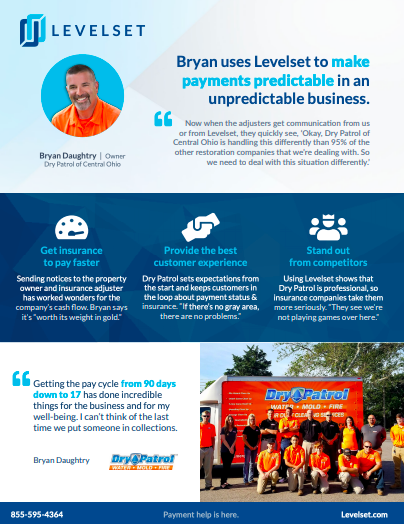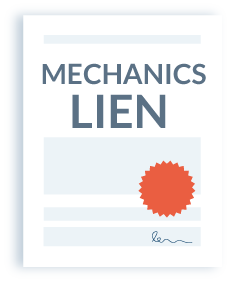
From the outside, it might seem that working for insurance companies on behalf of homeowners in need is a solid business plan with very little room for error. Anyone who’s ever done this type of work knows better. Restoration contractors definitely face their own challenges, not least of which is trying to navigate insurance claims so they can get paid.
While there will always be work and money for the making, restoration contracting is anything but straightforward. Most of the parties involved in restoring a family’s home have minimal actual construction experience. They might not realize how much materials cost. Their inexperience can slow down the construction process, including the part when it comes time for you to get paid.
Here’s what restoration contractors need to understand about insurance claims — and how to protect their payment rights in the process.
Why insurance companies delay restoration claims
By far, the most challenging part of restoration work is not the actual work; it’s getting paid. Insurance companies are notorious for dragging their feet on payments, causing the restoration company’s cash flow to suffer. There are many reasons for this, and once you read them, you’ll understand how they work and why they don’t rush to pay anyone.
Interest
Insurance companies make money in two ways: through a positive premium to claim ratio and interest on the premiums they collect. They invest the money they make and premiums they receive for the interest.
Insurance companies will often take their premiums and invest in short-term assets to make as much interest as possible while also playing it safe. Popular choices are treasury bonds, corporate bonds, and cash equivalents.
The longer that an insurance company can let their money sit in an interest-bearing account, the more interest they’ll receive. Since this is how they make a lot of their money, they’re not interested in pulling the cash out to pay you, as they’ll lose the interest they were gaining on it.
Further reading: Insurance vs. Bonds: What Contractors Need to Know
As an example, Liberty Mutual reported $274 million in third-quarter profits in 2019. While that’s an impressive number, it pales in comparison to State Farm’s $79.4 billion profit for all of 2019.
That’s not all interest, but it does provide some perspective as to how much money is in play.

How to reduce your pay cycle
We worked with one restoration contractor to reduce their pay cycle from 90 days down to just 17.
Disputes
The process for a homeowner to file a claim isn’t always as straightforward as an insurance company spokesperson makes it out to be. A major cause of these disputes arises when the insurance company adjuster and the homeowner have different views on the damage’s value.
At the beginning of the claim process, an adjuster needs to assess the damage and create a quote. The adjuster’s goal is to replace what the homeowner had. The homeowner may want to replace the value of what they had, not necessarily the items or home itself. Often, homeowners need to prove not only what they had, but also the condition of the home before the damage. That takes time.
Related: 7 tips when dealing with insurance adjusters and homeowners
A restoration contractor may also struggle to find middle ground with an adjuster. They often handle the emergency before the claim has even started. The insurance company may find the charges to be in excess of what they’re willing to pay. Also, when the restoration estimate comes in, it may be less than the restoration contractor was expecting.
In most cases, a restoration contractor cannot negotiate the terms of the estimate, but they can discuss them with the adjuster.
Insurance policy coverage
Depending on the type of damage that a restoration contractor comes in to fix, there can be many moving parts involved in the claim. An insurance company may want to sort through the entire claim before cutting checks.
A single insurance policy doesn’t cover every type of damage. A typical homeowner’s policy will likely cover storm damage, from a fallen tree or lightning strike for example. But a claim for damage from floods or earthquakes will typically require additional coverage. It takes time for the insurance company to verify not just the extent of the damage, but the cause of it. If it wasn’t covered by the policy, the homeowner will need to pay for the restoration out of pocket.
Even if the homeowner’s policy does cover the restoration work, there are other factors that will delay a restoration contractor’s work (and payment).
If the damage to the home is extensive, there’s a good chance that the residents have to find somewhere else to stay. The homeowners need to find a place temporary home, which ultimately will come out of the insurance company’s pocket. But that also means no one will be home. This can be a challenge in the early stages of the restoration, as the contractor and adjuster won’t have access to the home.
Other factors, including challenges with utility companies and municipalities may also factor in. Sometimes the costs and pressures of these factors outweigh the restoration contractor’s stake.
These are just some of the moving parts that can significantly slow your payment.
Learn more – Assignment of Benefits for Contractors: Pros & Cons of Accepting an AOB
Why homeowners delay payment after an insurance claim
Most of the time, it’s safe to assume that the homeowner you’re working for has very little experience in either insurance or construction. It’s probably the first time they’ve dealt with a disaster as well. The restoration contractor rides in, hoping to be the knight in shining armor.
Sometimes, however, the customer sees things quite differently. After a major disaster, it’s not unusual for restoration contractors to flock to the area from all over the country. Homeowners are often afraid of being taken advantage of by a fly-by-night restoration outfit, and may hem and haw over the pricing, and drag their feet on payment.
Dealing with a skeptical homeowner is a problem because the insurance companies write the claim check to the homeowner, not to the restoration contractor directly. That check may be the largest one the homeowner has ever seen. The owner may decide that they don’t want to pay for the work, instead pocketing the cash and blocking your calls.
Fortunately, a smart restoration contractor knows how to protect themselves against non-payment risk, whether the insurance company or the homeowner is the cause of the delay.
Learn more: 8 Ways for Contractors to Build Trust With a Homeowner
How restoration contractors can speed up insurance claims and get paid
Since you already know that the insurance companies involved in your restoration projects are in no rush to get you paid, you need to be proactive about speeding up your payment. Here are a few steps you can take to reduce the amount of time it takes to get paid on a restoration project.
Sending preliminary notices is the first step to protecting insurance payment
Restoration contractors work quickly, responding to an emergency and getting the homeowner back up and running as soon as possible. Because they use this shot-out-of-the-gate business model, they may overlook preliminary notices.
Preliminary notices provide a wealth of benefits. They improve communication, show that you’re a professional outfit and understand your rights, and set your expectation to get paid. They’re your introduction to the parties involved, and very often, they protect your lien rights.

Discover how sending notices helped a restoration company shorten their payment cycle to 17 days.
Even if you’re not implementing preliminary notices before you start work, the good news is that by the nature of your business, you may still have time. Because most restoration contractors work quickly, they often fall within the time frame for most state requirements even after completing the project.
In fact, some restoration contractors find that sending a notice at the end of the job is the best way to get paid faster. This method puts your name in front of the insurance company before they cut the checks. It also helps to remind the parties that you know your rights.
How a Notice of Intent can help
If you haven’t received payment for your restoration work, the homeowner might not realize that there’s an issue. Most likely, they’re waiting for payment as well. When you send a notice of intent to lien (NOI) that details how close they are to having a lien against their home, they’ll realize the deadline is looming. They’ll reach out to the insurance company and hold their feet to the fire, hopefully producing your payment.
While it doesn’t hurt to send an NOI to the insurance company, that alone might not produce a payment. It may start an investigation as to what happened with the check they cut to the homeowner however.
If the homeowner has a mortgage on the property, sending an NOI to the mortgage company or bank is sure to cause a reaction. Banks want their mortgage properties lien-free so they’re as liquid as possible if they have to foreclose on them. An NOI explaining that a mechanics lien is coming will likely speed up the payment process. Of course, this assumes that you collected the mortgage company’s information in the first place!
In either of these scenarios, a notice of intent to lien is often all it takes to get the ball rolling. The preliminary notice has protected your payments, but the NOI shows you’re serious about filing a mechanics lien.
A mechanics lien is a restoration contractor’s best protection
It’s important to keep a close eye on your mechanics lien deadline, since a lien claim is a contractor’s strongest payment protection. If payment is late, a restoration contractor may need to file a mechanics lien while the homeowner waits for the insurance claim to be paid.

File a lien now!
Levelset takes all of the guesswork out of the filing process. We’ll research the project information and ensure your claim is done right.
Filing a mechanics lien on a property will hopefully speed things up, but it will definitely help secure your interest. No one wants a lien placed on their property. Homeowners are likely to start negotiating to settle the debt before it goes any further.
Case in point: A homeowner in Maryland asked a question about this very scenario. The insurance company was dragging their feet on payment. Rather than wait for filing deadline to pass and hope for the best, the restoration contractor filed a lien.
Even if the owner and insurance company promise to pay, there are never any guarantees in construction. A promise to pay is not a payment until the money is in your bank account.
If the owner or insurance company doesn’t pay, you have the right to enforce the lien and foreclose on the property in order to collect your payment. You’ll have to start the lawsuit process, so be sure that you document the progress of the job from start to finish. The good news is that you’ll probably be able to roll your court costs into the lien’s amount.